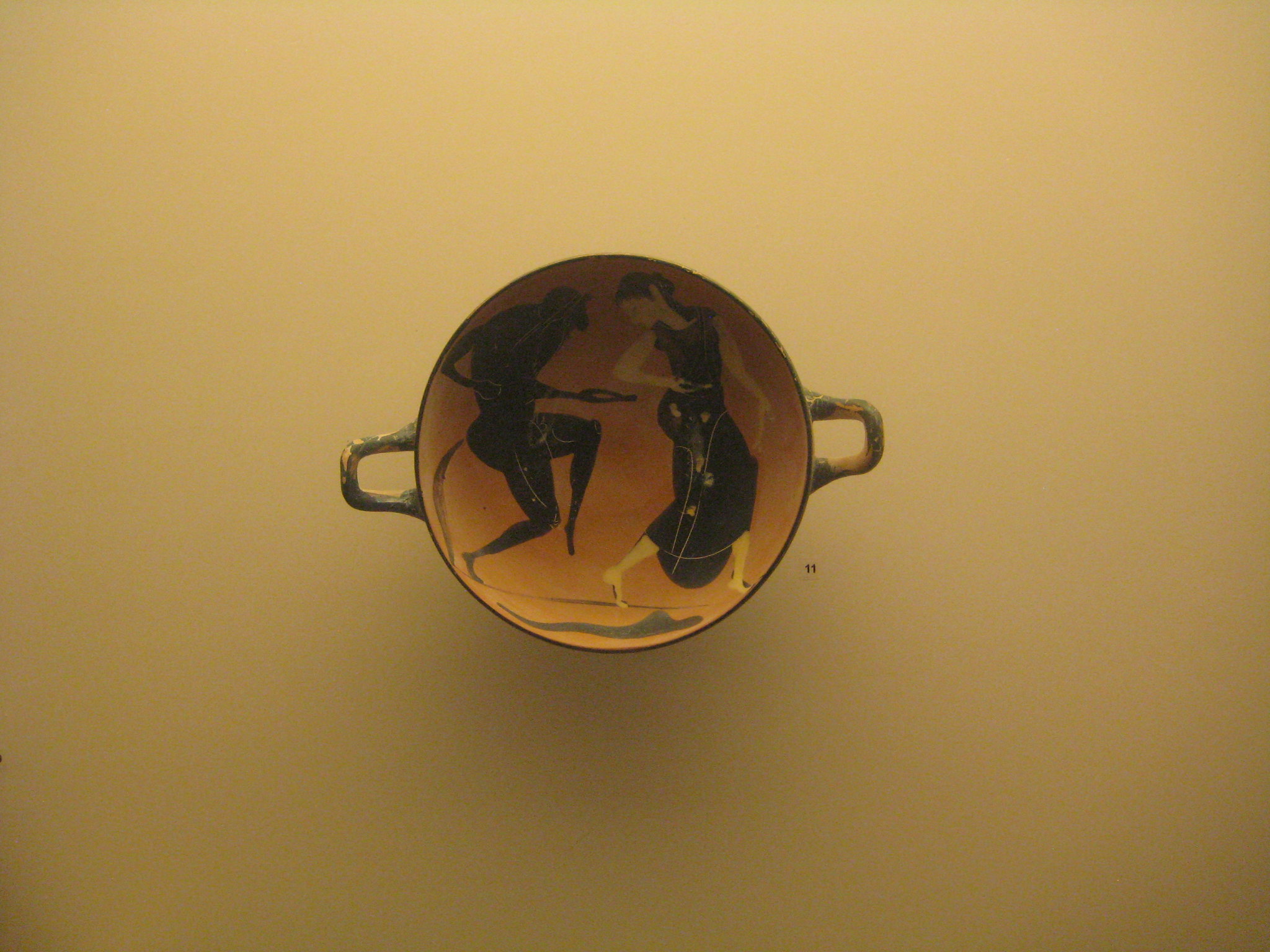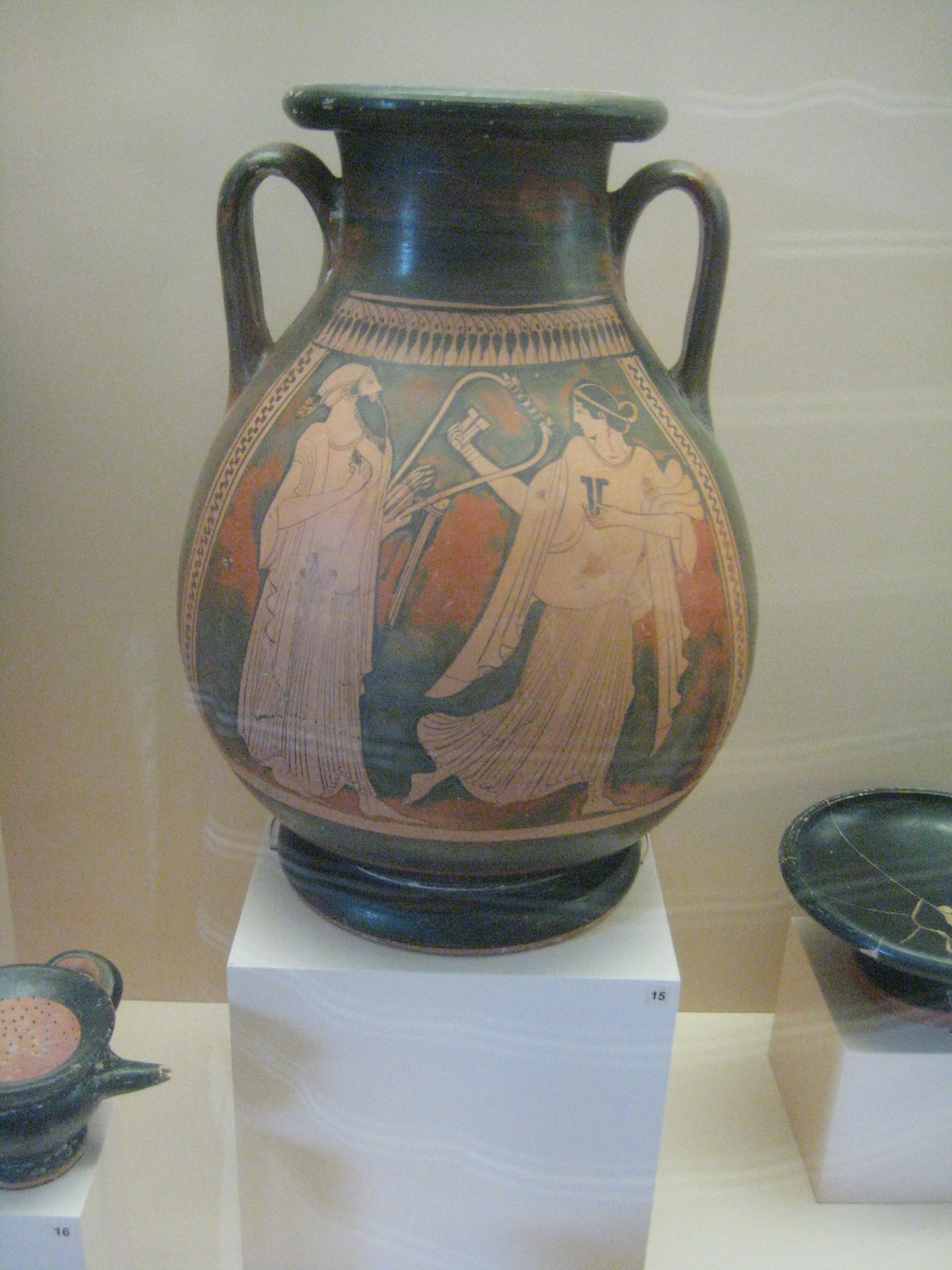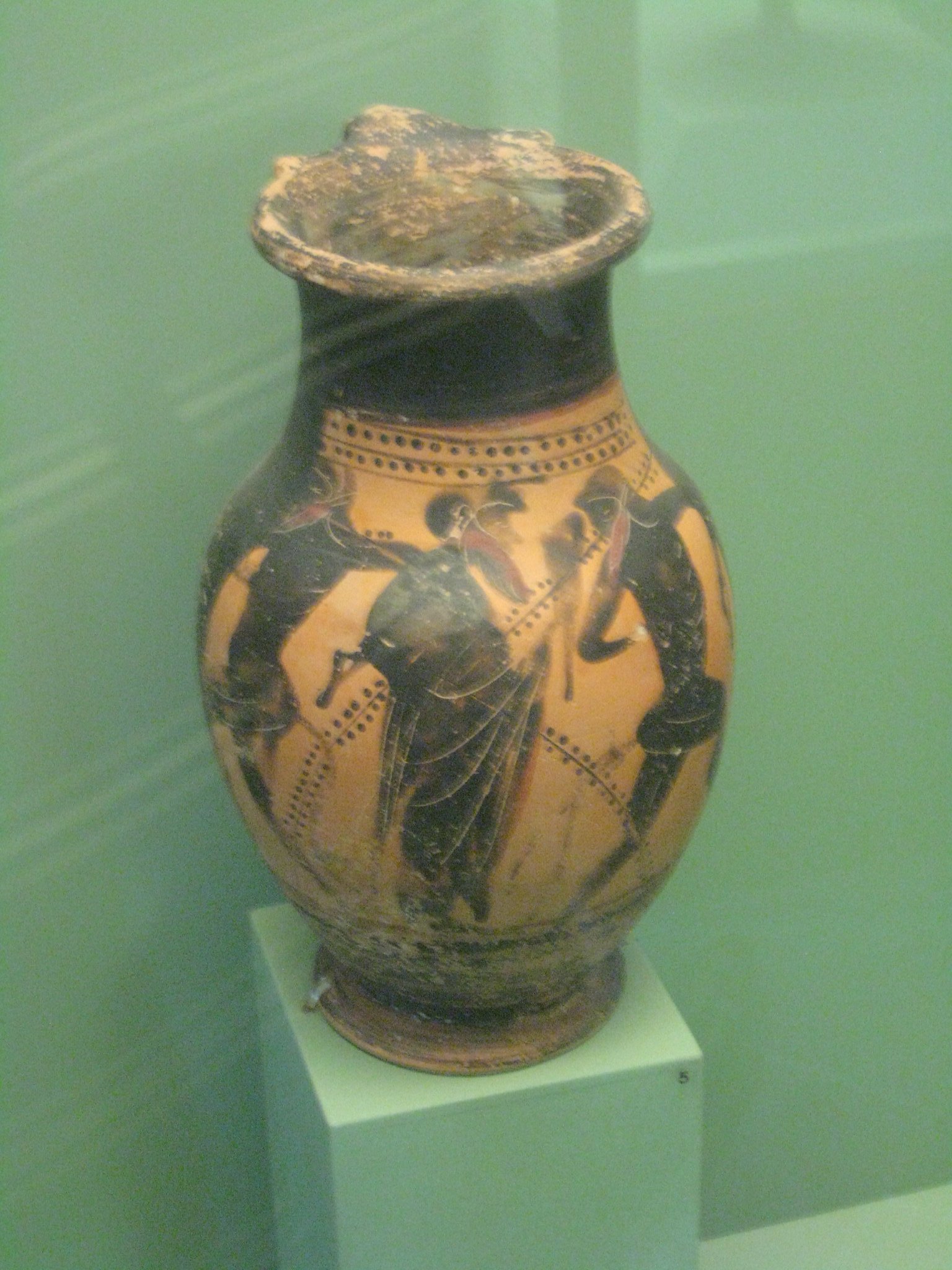- Dionysos = from Greek Διος (Dios) meaning "of ZEUS" combined with NYSA, the name of the region where young Dionysos was said to have been raised. In Greek mythology Dionysos was the god of wine, revelry, fertility and dance. He was the son of Zeus and Semele.
Bacchus = from Greek Βακχος (Bakchos), derived from ιαχο (iacho) meaning "to shout". This was another name of the Greek god Dionysos, and it was also the name that the Romans commonly used for him. Bacchus is how the Lydians called Dionysos.
Dionysos was the god of theatre because he was the god of illusion. He was often represented by a mask attached to a wooden pole. He appears in diguise.
Herodotus equates the Egyptian god Osiris with Dionysos. Both gods are associated with wine, agriculture, and the cycle of death and rebirth. Osiris was a god of the dead, but he was also a god of vegetation and fertility. His death and resurrection were celebrated in the annual festival of Khoiak, which was a time of great feasting and revelry.
After the Greeks had come into contact with the Egyptians around the 7th century BC, they soon began to identify their gods with each other. Osiris was identified with Dionysos because both gods were associated with wine and the cycle of death and rebirth.
Christians might perceive Dionysos to be a version, perhaps a precursor, of Christ: Zeus (the chief god) impregnates a mortal virgin (Semele); she gives birth to Dionysos, who is half god and half man. Zeus cannot appear to mortals, he burns them up. In Euripides Bacchae, Dionysos appears in disguise as a priest of his cult. In reality, an actor, a human, is playing Dionysos who is half human half god. This is a kind of Trinity. Much of religion, and certainly its rites are theatrical. Often a religious experience is to find one's way behind the illusion.
The word "maenad" comes from the Greek word "mainas," which means "mad" or "demented." This suggests that the maenads were originally seen as wild and frenzied women who were possessed by the god Dionysos. Sometimes Maenads were also known as Thyades. Origin of the Maenads, one myth says that they were originally the nymphs who were the nursemaids to the infant Dionysus. When Dionysus grew up, he gave them the gift of divine madness, which allowed them to experience ecstasy and frenzy. Another myth says that the maenads were originally women who were driven mad by drinking too much wine. In the cult of Dionysos, they were said to roam the mountains and forests, dancing and singing in a state of ecstasy. Wild and violent, they were often depicted tearing animals or people to pieces. When depicted they often carried thyrsi, which are staves topped with pinecones. Because they represented the wild and untamed side of nature they had powers over nature itself and were able to control animals and even the weather. As well as being destructive and violent, they could also be benevolent and protective.
https://bakcheion.wordpress.com/
Lenaia (2015) | The Geekie Hellenist
The Four Main Festivals in Attica/Athens celebrating Dionysos
The Rural Dionysia
Rural Dionysia - Wikipedia
The Lenaia
Lenaia - Wikipedia
Anthesteria - Greek festival - Britannica
The City or Great Dionysia
City Dionysia - Wikipedia
Sanctuaries dedicated to Dionysos in or near Ancient Athens
The Dionysian Theatre: The most famous sanctuary of Dionysos in Athens was the Dionysian Theatre, which was located on the south slope of the Acropolis. It was built in the 5th century BC and was used for dramatic performances during the Athenian festivals of Dionysos, including the City Dionysia.
The Lenaion or Lenaeum: The Lenaion was a sanctuary of Dionysos located in the Agora of Athens. It was believed to be the site where Dionysos was first worshipped in Athens, and it was the centre of the Lenaia festival, which honoured the god of wine and fertility. Dionysus - Carl Kerényi - Google Books Dionysos: archetypal image of indestructible life: Kerényi, Karl, - Internet Archive
Bates, W. N. (1899). The Lenaea, the Anthesteria, and the Temple F5;̓ν Λίμναις Transactions and Proceedings of the American Philological Association, 30, 89–98. https://doi.org/10.2307/282563 https://www.jstor.org/stable/282563The Limnaios: The Limnaios (Muddy or Swamps) was a sanctuary of Dionysos located near the Ilissos River in Athens. According to Thucydides, the temple of Dionysos Limnaios was situated to the south of the Akropolis and was one of the city's oldest sanctuaries. It was a popular spot for drinking parties (symposia), and it was believed to be the place where the god was born. Dionysos p.292-4 - Carl Kerényi - Google Books
The Dionysos Eleuthereus: Dionysos Liberator was a sanctuary located outside the city walls of Athens, near the village of Acharnae. It was dedicated to Dionysos as the god of freedom and was the site of the Anthesteria festival, which celebrated the arrival of spring. A Dictionary of Greek and Roman biography and mythology, Eleuthereus
The Agrai: The Agrai was a sanctuary of Dionysos located on the slope of Mount Hymettos, outside the city of Athens. It was believed to be the site where Dionysos was first welcomed to Attica, and it was the centre of the Agrionia festival, which honoured the god's wild and untamed nature.
- Eleusinion: Located on the northwest slope of the Acropolis, this sanctuary was dedicated to both Demeter and Dionysos. It was the site of the famous Eleusinian Mysteries, which were secret religious rites in honour of Demeter and Persephone.
- Lenaios: This sanctuary was located on the northwest slope of the Acropolis, near the Eleusinion. It was dedicated to Dionysos Lenaios, a form of the god associated with the production of wine.
- Bendis: This sanctuary was located outside the walls of Athens, near the Academy. It was dedicated to Bendis, a Thracian goddess associated with hunting and the moon. The sanctuary also included a shrine to Dionysos.
Dionysus - Wikiwand
Greek Religion - Dionysos pp 161ff: Burkert, Walter: - Internet Archive
From The Cult Of Dionysus To The Theatrical Act : General Supervision: Dr. Maria Lagogianni, Archaeologist Suzanna Choulia-Kapeloni, Archaeologist Supervision of Publication: Elena Bazini, Archaeologist Graphics - Artistic supervision: Spilios Pistas, Graphic designer Texts: Maria Aggelakou, Archaeologist Translation: Maria Michalarou Production: Pressious Arvanitidis // © 2015 Hellenic Ministry of Culture, Education and Religious Affairs General Directorate of Antiquities and Cultural Heritage - Internet Archive
After Dionysus : a theory of the tragic : Storm, William - Internet Archive
Dictionnaire des antiquités grecques et romaines, d'après les textes et les monuments : C.V. Daremberg - Internet Archive BACCHUS pp. 591-639
Mystery Cults, Theatre and Athenian Politics: A Reading of Euripides ... - Luigi Barzini - Google Books
Mystery Cults and the Polis of Athens: A Reading of Bakchai and Frogs Exeter University These
Tragedy and Athenian Religion - Christiane Sourvinou-Inwood - Google Books
Dionysos - Richard Seaford - Google Books
Front panel of a sarcophagus with scenes from the life of Dionysos (y1949-110) Princetown Art Museum
Zeitlin, F. I. (1982). Cultic Models of the Female: Rites of Dionysus and Demeter. Arethusa, 15(1/2), 129–157. http://www.jstor.org/stable/26308107.
Mystery Cults, Theatre and Athenian Politics - Google Books
Choes and Anthesteria: Athenian iconography and ritual : Hamilton, Richard - Internet Archive
Le Culte de Dionysos en Attique: P.F. Foucart - Internet Archive
Ritual Irony: Poetry And Sacrifice In Euripides
Names of Dionysos:-
Dionysos Character in Mythopoeia - World Anvil
Guthrie, W. K. C. (1963). [Review of Der frühe Dionysos, by K. Kerényi]. The Classical Review, 13(3), 353–353. http://www.jstor.org/stable/708190.
Dionysiaca Vol 1: Nonnus, of Panopolis - Internet Archive
Redefining Dionysos - Internet Archive
Der frühe Dionysos : die Eitrem Vorlesungen, gehalten an der Universität Oslo im September 1960 : Kerényi, Karl - Internet Archive
Man, Myth & Magic vol. 5 -Dionysus - Internet Archive
A History of Religious Ideas - Chapter 15 Dionysus, or Bliss Recovered by Mircea Eliade - Internet Archive
Vürtheim, J. (1920). The Miracle of the Wine at Dionysos’ Advent; On the Lenaea Festival. The Classical Quarterly, 14(2), 92–96. http://www.jstor.org/stable/636514
Dionysos and Tragedy
"Tragedy and Dionysus" is a chapter by Richard Seaford in the book A Companion to Tragedy. In the chapter, Seaford argues that Athenian tragedy originated from the cult of Dionysos.
- Drama came into being when the chorus leader broke away from the chorus to address the chorus.
- The tragedy festival itself belonged to the cult of Dionysos.
- The social elements of drinking led to gatherings, festivals, and other occasions that were fertile for the development of drama.
- The Great Dionysia, the major festival where tragedy took centre-stage, arose in the 6th century BC to serve a political end.
Dionysus is known for having a dual personality, bringing joy, ecstasy, and merriment, but also delivering "brutal and blinding rage".
References
"Tragedy and Dionysus" by Richard Seaford pages 25-38 in A Companion to Tragedy, ed. Rebecca Bushnell, Wiley-Blackwell 2009
https://melpomeneswork.com/tragedy-and-dionysus-seaford
A Companion to Tragedy - Google Books
https://onlinelibrary.wiley.com/doi/abs/10.1002/9780470996393.ch3
Scullion, S. (2002). “Nothing to Do with Dionysus”: Tragedy Misconceived as Ritual. The Classical Quarterly, 52(1), 102–137. http://www.jstor.org/stable/3556447
Iacchus
Iacchus - Greek mythology - Britannica
IACCHUS (Iakkhos) - Greek God of the Ritual Cry of the Eleusinian Mysteries
Dionysos with satyrs and maenads. Black-figured hydria, Attica, Greece, c. 520 BC.
Location: British Museum
British museum dept. of Gr. and Rom. antiq (1851). A catalogue of the Greek and Etruscan vases in the British museum. Item 447 Hydria. pp. 43–.
British Museum - Image gallery- hydria
Museum number 1849,0620.11
- https://kosmossociety.chs.harvard.edu/?p=20788
Henrichs, A. (2014). Dionysus (linear b diwonusos). In S. Hornblower, A. Spawforth, & E. Eidinow (Eds.), The Oxford companion to classical civilization (2nd ed.). Oxford University Press, Inc. Credo Reference: https://search.credoreference.com/content/entry/oupocc/dionysus_linear_b_diwonusos/0?institutionId=599
Cults Of The Greek States Vol.5 : Farnell, Lewis Richard - Internet Archive
The Cult of Pan in Ancient Greece (1988) by Philippe Borgeaud Archived
Robin Hard; H. J. Rose (2004). The Routledge Handbook of Greek Mythology: Based on H.J. Rose's "Handbook of Greek Mythology". The Satyrs and Silenoi: Psychology Press. pp. 212–. ISBN 978-0-415-18636-0.
Park McGinty (19 July 2011). Interpretation and Dionysos: Method in the Study of a God. Walter de Gruyter. pp. 1–. ISBN 978-3-11-080182-8.
The Greeks and the irrational (1973 edition) - Open Library
Walter Friedrich Otto (1995). Dionysus: Myth and Cult. Indiana University Press. ISBN 0-253-20891-2.
Dionysus, myth and cult. : W. F. Otto - Internet Archive
Dionysos at Large: Marcel Detienne - Internet Archive
Christiane Sourvinou-Inwood (2003). Tragedy and Athenian Religion. Lexington Books. ISBN 978-0-7391-0400-2.
Eric R. Dodds (16 June 2004). The Greeks and the Irrational. University of California Press. ISBN 978-0-520-93127-5.
John Boardman; J. K. Davies; M. Ostwald (1992). The Cambridge Ancient History - Volume V. Chapter 8: B. Knox - Athenian religion and literature: Cambridge University Press. pp. 268–. ISBN 978-0-521-23347-7.
Cornelia Isler-Kerényi (2007). Dionysos in Archaic Greece: An Understanding Through Images. BRILL. ISBN 90-04-14445-5.
Cornelia Isler-Kerényi (14 November 2014). Dionysos in Classical Athens: An Understanding through Images. BRILL. ISBN 978-90-04-27012-1.Apollodorus, tr Robin Hard (1998). The Library of Greek Mythology. Book 3.4 Semele and Dionysos - Death of Actaion: Oxford University Press. pp. 101–. ISBN 978-0-19-283924-4
CORNELIA ISLER KERENYI Dionysos In Classical Athens 2015 - Internet Archive
H. S. Versnel (1990). Inconsistencies in Greek and Roman Religion. 1, Ter Unus: Isis, Dionysos, Hermes, Three Studies in Henotheism. BRILL. ISBN 90-04-09266-8.
Alberto Bernabé; Miguel Herrero de Jáuregui; Ana Isabel Jiménez San Cristóbal (26 June 2013). Redefining Dionysos. De Gruyter. ISBN 978-3-11-030132-8.
Jennifer Larson (2007). Ancient Greek Cults: A Guide. Chapter 10: Epiphany and Transformation: Psychology Press. pp. 126–. ISBN 978-0-415-32448-9.
After Dionysus: A Theory of the Tragic - Google Books https://bit.ly/32JswAq.
Dionysos: archetypal image of indestructible life: Kerényi, Karl - Internet Archive
Thyrsus - Wikipedia
Museu Calouste Gulbenkian
 |
| Satyr chasing Maenad |
Greek vase - Museu Calouste Gulbenkian
http://museu.gulbenkian.pt/minisites/tesourosdomuseu/umvasogrego/english/index.html#page_Blog
Provenance - The Classical Art Research Centre
302996, London, British Museum, B178Dionysos With Ivy And Kantharos Between Satyrs, One Playing Kithara, One With Drinking Horn And Wineskin, Goat
 |
| Psykter: Vase E768 CVA British Museum 6 III Ic Pl. 105, 1 British Museum - psykter |
References
Maenad - Wikipedia
Thiasus (Thiaos) - Wikipedia
The thiasus (Greek thiasos), was the ecstatic retinue of Dionysos, often pictured as inebriated revelers.
Thyrsus - Wikipedia
Democratizing Dionysus: The Origins Controversy and the Dual Evolution of Tragedy and Civism
by B Plaza-Gainza · 2015
Simon Hornblower; Antony Spawforth; Esther Eidinow (2012). The Oxford Classical Dictionary. maenads: OUP Oxford. pp. 883–. ISBN 978-0-19-954556-8.
Bremmer, J. N. (2014). Maenads. In S. Hornblower, A. Spawforth, & E. Eidinow (Eds.), The Oxford companion to classical civilization (2nd ed.). Oxford University Press, Inc. Credo Reference: https://search.credoreference.com/content/entry/oupocc/maenads/0?institutionId=599
Alan B. Lloyd (1976). Herodotus, Book II: Commentary 1-98. BRILL. pp. 114–. ISBN 90-04-04179-6.
Karl Kerényi (1996). Dionysos : archetypal image of indestructible life. Princeton University Press. ISBN 0-691-02915-6.
Marvin W. Meyer (7 May 1999). The Ancient Mysteries: A Sourcebook of Sacred Texts. Chapter 4 The Greek Mysteries of Dionysos: University of Pennsylvania Press. pp. 63–. ISBN 0-8122-1692-X.Maenads, Women Followers of Dionysus
Euripides' Bacchae, Classical Drama and Theatre
Euripides (1979). tr Professor Kirk. Bacchae of Euripides. The Prologue: Lines 1-63: CUP Archive. pp. 23–31. ISBN 978-0-521-29613-7.
SILENUS Greek God of Drunkenness & Wine-Making Mythology, Seilenos
https://www.ancient.eu/Dionysos/
https://www.ancient.eu/image/642/maenad-red-figure-cup/
Brussell, David Eric. “Medicinal Plants of Mt. Pelion, Greece.” Economic Botany, vol. 58, 2004, pp. S174–S202. JSTOR, www.jstor.org/stable/4256917.
Dionysos : archetypal image of indestructible life : Kerényi, Karl - Internet Archive
Maenads - Oxford Reference
The Maenads: A Contribution to the Study of the Dance in Ancient Greece
Lillian B. Lawler
Memoirs of the American Academy in Rome
Vol. 6 (1927), pp. 69-112
Published by: University of Michigan Press for the American Academy in Rome
Stable URL: http://www.jstor.org/stable/4238532
Allan, William. “Religious Syncretism: The New Gods of Greek Tragedy.” Harvard Studies in Classical Philology, vol. 102, 2004, pp. 113–155. JSTOR, www.jstor.org/stable/4150035
Dionysus-Osiris - Wikipedia
Greek and Egyptian Religious Parallels
Rosemarie Taylor-Perry (2003). The God who Comes: Dionysian Mysteries Revisited. Algora Publishing. pp. 5–. ISBN 978-0-87586-230-9.
Sarah Peirce
Classical Antiquity
Vol. 17, No. 1 (Apr., 1998), pp. 59-95 (46 pages)
Published by: University of California Press
DOI: 10.2307/25011074
https://www.jstor.org/stable/25011074
Dionysus - Wikipedia
Pan (god) - Wikipedia
The Oxford Classical Dictionary (3 ed.) Dionysus - Internet Archive
Richard Seaford (2006). Dionysos. Routledge. ISBN 1-134-34450-3.
DIONYSUS - Greek God of Wine & Festivity - Mythology, Dionysos, w- pictures - Roman Bacchus
CULT OF DIONYSOS 1 Ancient Greek religion
Le culte de Dionysos en Attique Foucart
The Rites in the Mysteries of Dionysus The Birth of the Drama - Journal.fi
Eric Csapo; Margaret C. Miller (2007). The Origins of Theater in Ancient Greece and Beyond: From Ritual to Drama. Cambridge University Press. ISBN 978-0-521-83682-1.
Eli Rozik (2005). The Roots of Theatre: Rethinking Ritual and Other Theories of Origin. University of Iowa Press. ISBN 978-1-58729-426-6.
Cornelia Isler-Kerényi (2007). Dionysos in Archaic Greece: An Understanding Through Images. BRILL. ISBN 90-04-14445-5.
Walter Friedrich Otto (1995). Dionysus: Myth and Cult. Indiana University Press. ISBN 0-253-20891-2.
Christiane Sourvinou-Inwood (2003). Tragedy and Athenian Religion. Lexington Books. pp. 67–. ISBN 978-0-7391-0400-2.
John Peradotto; John Patrick Sullivan (1984). Women in the Ancient World: The Arethusa Papers. SUNY Press. pp. 107–. ISBN 978-0-87395-772-4.
Classic myth and legend [page 49-51 Dionysus ]: Moncrieff, Ascott Robert Hope, (1846-1927) - Internet Archive
Dionysos, Ecstasy, and The Forbidden
William Cassidy
Historical Reflections / Réflexions Historiques
Vol. 17, No. 1 (Winter 1991), pp. 23-44
Published by: Berghahn Books
https://www.jstor.org/stable/41298913
Isler_Kerenyi_2004_Civilizing Violence - Satyrs on 6th-Century Greek Vases .pdf
Archived - http://bit.ly/32genFw
Herodotus Histories
[Search for Dionysos and Privy Member]Primitive Athens as Described by Thucydides. CUP Archive
Beazley Archive - The Classical Art Research Centre and The Beazley Archive.
http://www.beazley.ox.ac.uk/archive/default.htm
The City of Dionysos: A Study of Euripides' Bakchai - Valdis Leinieks - Google Books
Being Like Greeks: Why Being Out of Our Minds Is Good For Us
Table of contents - Le sacrifice humain en Grèce ancienne - Presses universitaires de Liège
Author(s): Richard Seaford
Source: Arion: A Journal of Humanities and the Classics, Third Series, Vol. 11, No. 2 (Fall,
2003), pp. 1-19
Published by: Trustees of Boston University; Trustees of Boston University through its
publication Arion: A Journal of Humanities and the Classics
Stable URL: https://www.jstor.org/stable/20163921
Bacchae: Iphigenia at Aulis ; Rhesus - Ευριπιδες - Google Books
La Vénus à la fourrure (2013) - IMDb
Venus in Fur (2014) - Rotten Tomatoes





No comments:
Post a Comment